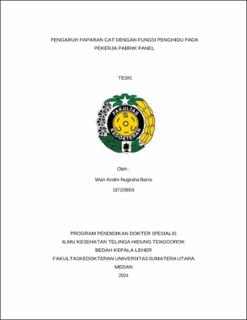Pengaruh Paparan Cat dengan Fungsi Penghidu pada Pekerja Pabrik Panel
Effect of Paint Exposure with Sniffer Function on Panel Factory Workers

Date
2024Author
Baros, Wan Andre Nugraha
Advisor(s)
Munir, Delfitri
Zahara, Devira
Metadata
Show full item recordAbstract
Background. Olfactory dysfunction can significantly impact an individual's quality of life, causing inability to detect gas leaks, distinguish spoiled food, and affect appetite and psychological well-being. Objective. The aim of this research was to determine the effect of exposure to paint on the function of smell on paint workers in a panel factory. Method. This cross-sectional study aimed to investigate the prevalence of olfactory dysfunction and its associated factors among paint workers in a panel factory in Medan, Indonesia. The study included 27 male paint workers who met the inclusion criteria. Olfactory function was assessed using the "Sniffin' Sticks" test, which evaluates odor threshold, discrimination, and identification. Results. The results revealed that 21 workers (77.8%) experienced hyposmia, while 6 workers (22.2%) had normal olfactory function. The mean age of workers with olfactory dysfunction was 47.38 years, compared to 41.5 years for those with normal function. However, the Mann-Whitney test showed no significant association between age and olfactory dysfunction (p=0.234). Among the 20 workers who smoked, 14 (70%) had hyposmia, while all 7 non-smokers experienced hyposmia. The Fischer's Exact test found no significant relationship between smoking habits and olfactory dysfunction (p=0.155). Conclusion. Paint workers are frequently exposed to chemicals such as toluene, xylene, ethylbenzene, acetone, and n-hexane, which can cause olfactory dysfunction through irritation and corrosion of the mucous membrane and damage to olfactory nerves. Factors influencing the risk of exposure include the level of exposure, duration of work, type of work, use of masks, presence of ventilation, and training received by workers. Further research is needed to explore the relationship between the duration of work and olfactory dysfunction among paint workers.
Collections
- Master Theses [204]
